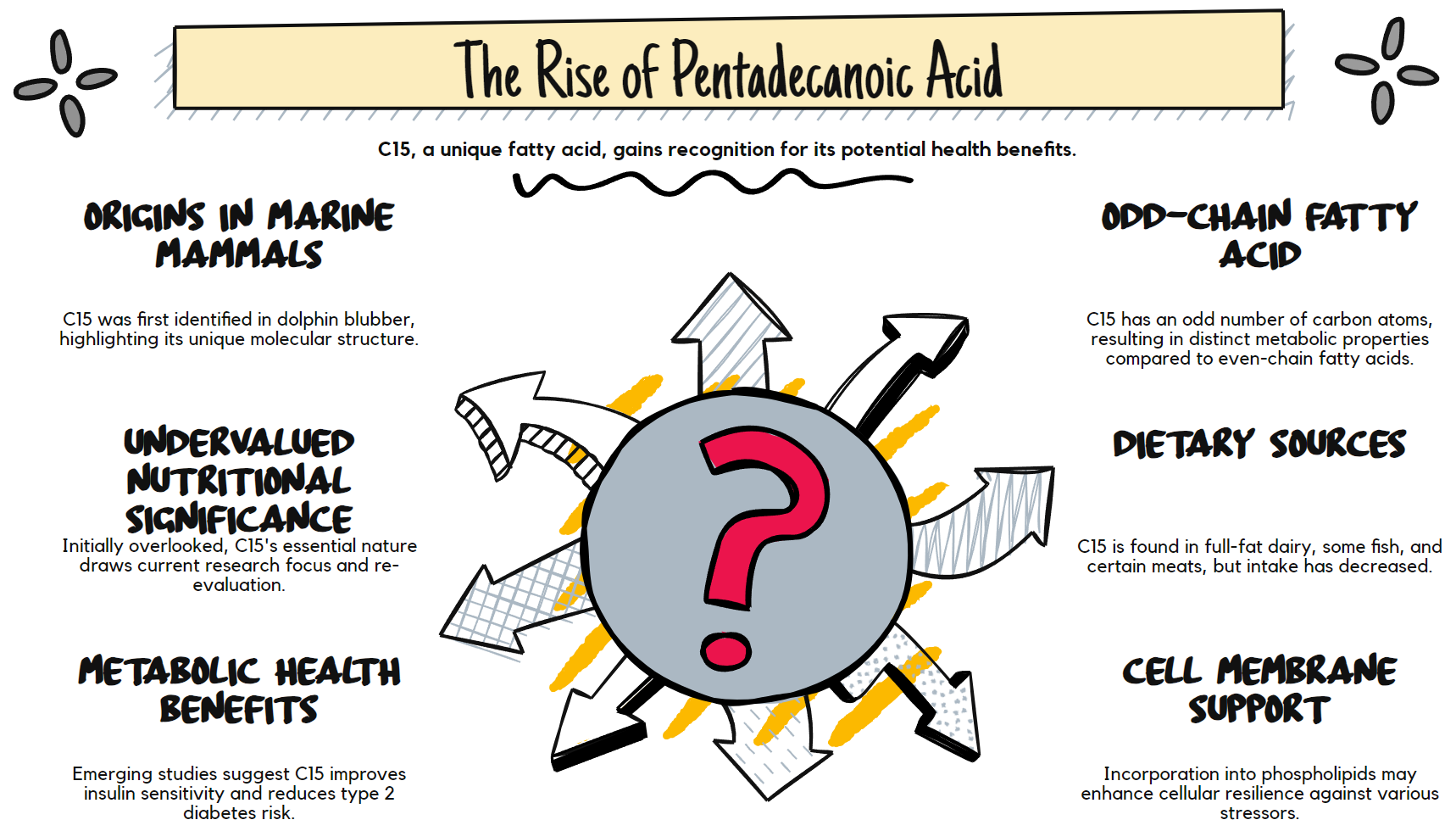
C15 Fatty Acid Emerges As Nutrition's Overlooked Essential
C15 Fatty Acid Emerges As Nutrition's Overlooked Essential
Hidden in plain sight. For decades. Pentadecanoic acid, better known as C15, remained virtually unknown outside specialized research circles. This odd-chain fatty acid first caught scientific attention in dolphin blubber studies, but now stands at the threshold of being recognized as essential for human health.
The story of C15 represents one of nutrition science's most fascinating journeys. From marine biology curiosity to a potential metabolic health cornerstone, this molecule challenges our understanding of what constitutes essential nutrition. As research accelerates, C15 increasingly appears central to metabolic regulation, cellular health, and disease prevention.
Let's explore the remarkable evolution of this once-overlooked compound through 15 illuminating facts that trace its path from obscurity to potential nutritional stardom.
Discovery and Early Research
Fact 1: C15 was first identified in significant concentrations in marine mammals, particularly dolphins, whose blubber contains substantial amounts of this odd-chain saturated fatty acid.
Fact 2: Unlike most fatty acids in the human diet, C15 has an odd number of carbon atoms in its chain. This unusual molecular structure contributes to its unique metabolic properties.
Fact 3: Early researchers largely dismissed odd-chain fatty acids as nutritionally insignificant, focusing instead on more abundant even-chain varieties like palmitic acid (C16) and stearic acid (C18).
Fact 4: The primary dietary sources of C15 for humans include full-fat dairy products, some fish, and certain ruminant meats. Modern nutritional shifts away from these foods have reduced typical C15 intake.
Metabolic Significance
Fact 5: C15 is a reliable biomarker for dairy fat consumption in human blood and tissue samples. Its presence correlates strongly with dietary habits involving dairy products.
Fact 6: Unlike many fatty acids, humans cannot synthesize C15 in significant amounts. This limited endogenous production suggests its potential essential status, requiring dietary sources.
Fact 7: Research indicates C15 may improve insulin sensitivity and glucose metabolism. Population studies show inverse associations between circulating C15 levels and type 2 diabetes risk.
Fact 8: C15 appears to strengthen cell membranes through its incorporation into phospholipids, potentially enhancing cellular resilience against various stressors.
Clinical Relevance
Fact 9: Multiple epidemiological studies have found inverse associations between C15 levels and cardiometabolic diseases. Higher blood concentrations correlate with reduced risk of heart disease and metabolic syndrome.
Fact 10: Researchers have observed that C15 may influence mitochondrial function, potentially explaining its broad metabolic effects. Proper mitochondrial operation remains central to cellular energy production and overall health.
Fact 11: Clinical investigations suggest C15 might help regulate inflammation pathways. This anti-inflammatory potential connects to numerous chronic disease processes.
Fact 12: Emerging evidence indicates possible neuroprotective properties, with preliminary research exploring connections between C15 levels and cognitive health outcomes.
Future Directions
Fact 13: Nutritional scientists increasingly advocate for reconsidering dietary guidelines regarding dairy fat consumption based partly on the potential benefits of its C15 content.
Fact 14: Supplement companies have begun developing C15 products, though questions remain about optimal delivery methods and dosing. The regulatory status of such supplements continues evolving as research advances.
Fact 15: Leading researchers now propose classifying C15 as conditionally essential, acknowledging its critical roles in metabolism despite limited endogenous synthesis capability.
Rethinking Nutritional Essentiality
The C15 story challenges our fundamental understanding of what makes a nutrient essential. Traditional definitions required clear deficiency diseases and demonstration of indispensable biological functions. C15 presents a more nuanced case, where absence doesn't create acute symptoms but may contribute to long-term metabolic dysfunction.
This emerging understanding reflects nutrition science's evolution from preventing deficiency diseases to optimizing health. As analytical technologies advance, researchers continue to uncover previously unrecognized bioactive compounds with significant health implications.
For consumers and healthcare providers, the C15 research suggests reconsidering the nutritional value of traditional foods like full-fat dairy products. While processed food manufacturers have removed fat to create "healthier" options, they may have inadvertently eliminated beneficial compounds like C15.
The journey from dolphin research curiosity to potential essential nutrient status exemplifies how scientific understanding evolves. What once seemed nutritionally irrelevant now appears increasingly crucial for optimal metabolic function.
As research continues, C15 may join the pantheon of essential nutrients that define human nutritional requirements. This odd-chain fatty acid reminds us that nutrition science remains a dynamic field where today's minor dietary component might become tomorrow's essential nutrient.
The greatest lesson from C15 research extends beyond this specific compound. It teaches us humility regarding nutritional knowledge and cautions against oversimplified dietary recommendations that might inadvertently eliminate beneficial compounds not yet fully understood.
